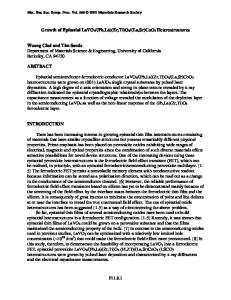Anomaly of Thermal Properties in Thin Films of La 1-x Sr x CoO 3 Series Fabricated as Thermoelectric Materials
- PDF / 457,105 Bytes
- 6 Pages / 612 x 792 pts (letter) Page_size
- 35 Downloads / 328 Views
V8.1.1
Anomaly of Thermal Properties in Thin Films of La1-xSrxCoO3 Series Fabricated as Thermoelectric Materials Yoshiaki Takata1,2, Hajime Haneda1,2,Yutaka Adachi2, Yoshiki Wada2, Takefumi Mitsuhashi2, Makoto Ohtani3, Tomoteru Fukumura1,4, Masashi Kawasaki1,4, and Hideomi Koinuma1,5 1 Combinatorial Materials Exploration and Technology (COMET), Namiki, Tsukuba, 3050044, Japan. 2 Advanced Materials Laboratory, National Institute for Materials Science, Namiki, Tsukuba, 3050044, Japan. 3 Innovative and Engineered Materials, Tokyo Institute of Technology, Midori-ku, Yokohama, 2268503, Japan. 4 Institute for Materials Research, Tohoku University, Aoba-ku, Sendai, 9808577, Japan. 5 Frontier Collaborative Research Center, Tokyo Institute of Technology, Midori-ku, Yokohama, 2268503, Japan. ABSTRACT Composition spreads of La1-xSrxCoO3 (LSCO) were synthesized as thermo-electric transducer material by means of combinatorial material synthesis, and information on their thermal diffusivity throughout the specimens was obtained. Meanwhile, it is anticipated that the composition spreads of LSCO have a variety of characteristic properties of light absorption corresponding to their composition, namely their compositional variable, x. Hence, we used transient optical pump-and-probe techniques in a reflection geometry to measure thermal diffusion times on LSCO. The results of signal analysis indicate that LSCO is a peculiar synthesized substance whose apparent thermal diffusivity, 1/τ, changes abruptly at the critical point, where the compositional variable x is equal to 0.3. INTRODUCTION It is hopefully expected that the invention of composition-spread preparation by synthesizing combinatorial materials helps to accelerate development of new materials [1]. With this background, the authors first synthesized a composition spread of LSCO as material for thermoelectric transducers, and evaluated thermal diffusivity as an important characteristic property [2]. Because the LSCO substances have a variety of characteristic properties of light absorption depending upon the compositional variable, x, we believe that there are no conventional analytical techniques versatile enough to analyze comprehensively the thermal diffusion of these synthesized substances. In this work, we have employed transient optical pump-and-probe techniques to heat the samples and measure transient thermal diffusion times. In these measurements, the third harmonic (266 nm) of a modelocked Ti:sapphire laser was used to heat a small spot on the sample. The heat-induced change in reflectivity was measured by probing the heated spot with light pulses at the fundamental wavelength (800 nm) as a function of time delay between the pump and probe pulses. Hence, this study evaluated the apparent thermal diffusivity of LSCO, by observing the time-resolved reflection of light, and we report on the apparent thermal diffusivity so obtained.
Downloaded from https://www.cambridge.org/core. Linkoping University Library, on 05 Jan 2020 at 07:31:08, subject to the Cambridge Core te










